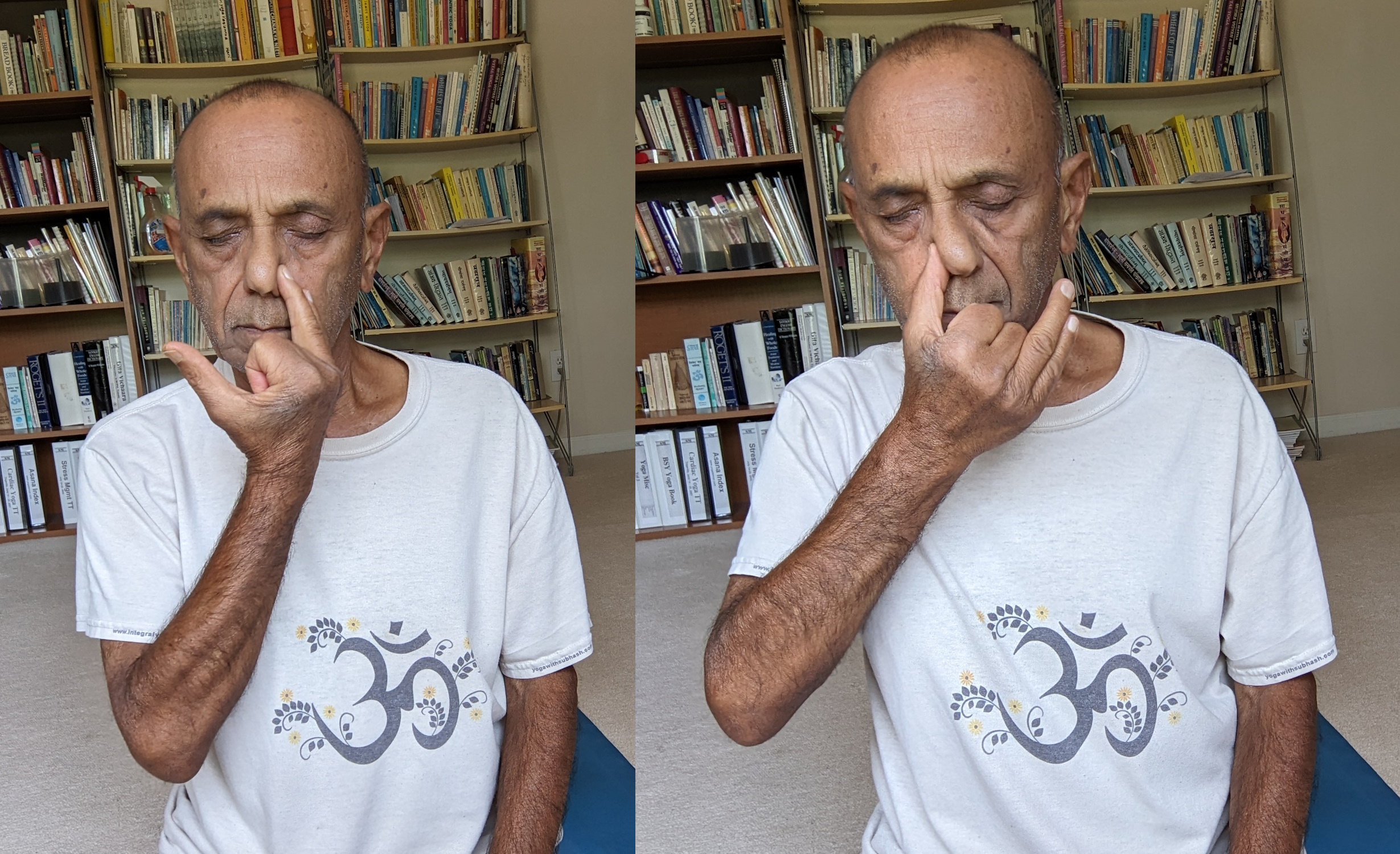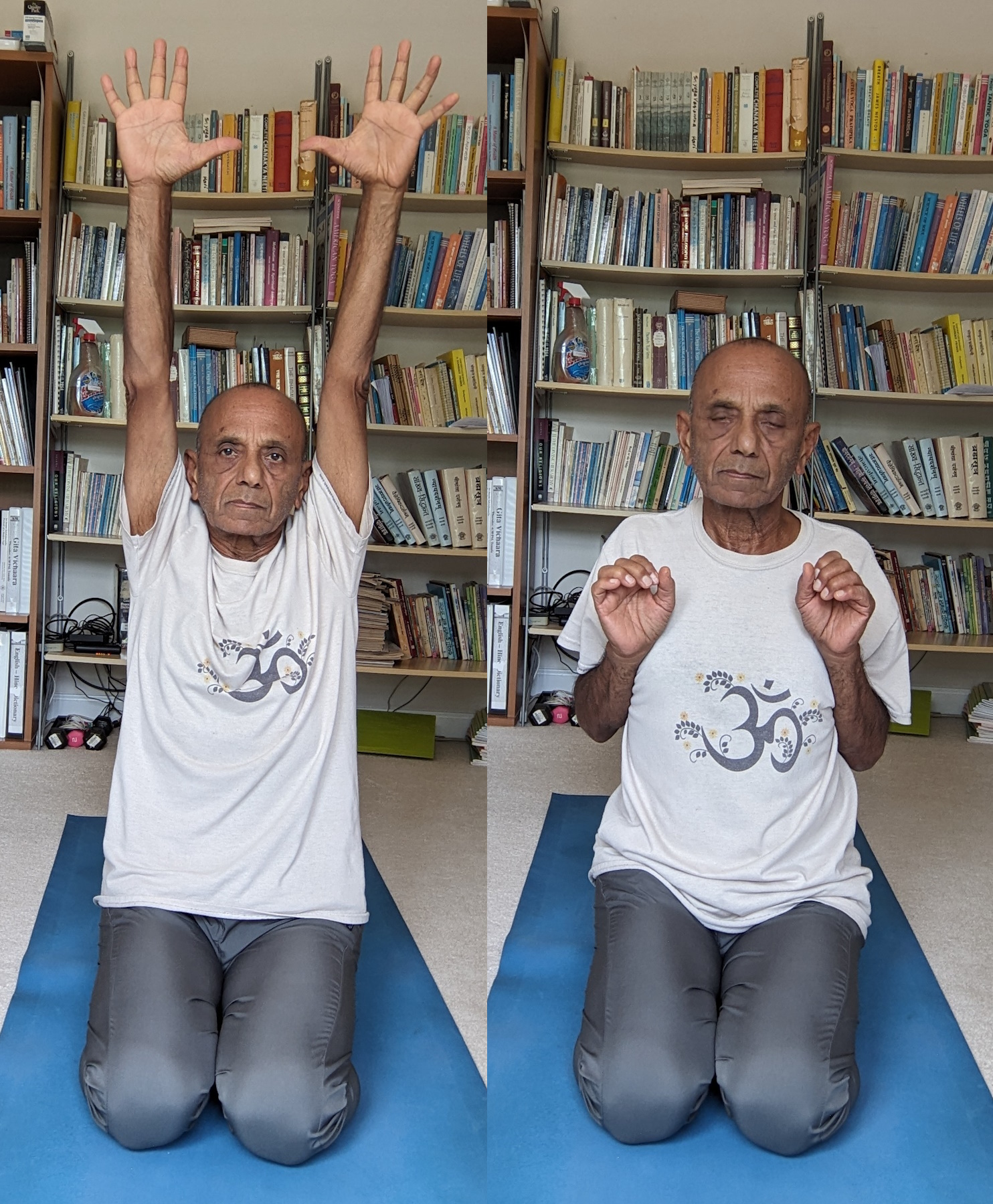If you recall, in the Kapalabhati pranayama, the emphasis is only on exhalation which is forced, short and brisk. The inhalation is passive and natural. During exhalation we also force the belly in toward the spine in a quick movement. In contrast, in the Bhastrika pranayama, both inhalation and exhalation are brisk, forced, short bursts of breath. Moreover, movement of the belly along with each breath is an optional variation.
‘Bhastrika’ (भस्त्रिका) is a Sanskrit word for the bellows – a device for producing a strong current of air that was used to fan fire in the old days. In this pranayama, the lungs are moved with movements that resemble the bellows.
Bhastrika is a very energetic breathing technique and must be practiced with a touch of caution. If at any time during the practice you feel light-headed, or uncomfortable in any manner, you should discontinue the routine and relax.
I will be giving here two different techniques for bhastrika. One is based on the classical approach given in the Hatha Yoga Pradipika. The other is a modified version of the technique and involves the movement of the arms and shoulders along with the breath.
I also recommend the use of a metronome so you can synchronize your breaths with the rhythm provided by the beats of the metronome. In the video demonstration below, we have used a metronome speed of 85 beats per minute. In your own practice, you may want to experiment with a few different speeds and see what works the best for you.
My friend Tanu Sharma has graciously agreed to be your guide for the video presentation. I hope you will enjoy practicing with the video.
Step-by-step (Technique 1)
This is the classical approach to Bhastrika as given in the Hatha Yoga Pradipika.
- Sit in any comfortable, cross-legged meditation posture with the spine upright, arms and shoulders relaxed.
- Set the metronome to the speed that you are comfortable with and start the metronome.
- Take a slow, deep inhalation.
- Exhale quickly and forcefully in a short burst of breath through the nose. Immediately, at the end of exhalation, inhale with the same force. Do not strain.
- During exhalation, the belly moves slightly in and during inhalation, the abdomen relaxes and fills out slightly. These movements of the belly are slightly exaggerated with conscious movement of the diaphragm.
- Try to maintain synchronization with the beats of the metronome.
- Continue for about twenty breaths. Then relax with normal breathing.
- Practice up to three rounds in the similar manner.
- After some practice, you may try to increase the speed as well as the number of breaths in each round, keeping the breathing rhythmical.
Variation 1
In this variation, we will practice Bhastrika first through one nostril at a time and then again through both the nostrils. In addition, at the end of the round, we will add the practice of breath retention and the application of Jalandahara bandha (chin lock).
- Using Vishnu Mudra with the right hand, close the right nostril with the thumb.
- Inhale slowly and deeply through the left nostril.
- Then breathe in and out with force through the left nostril, as described above.
- During exhalation, the belly moves slightly in and during inhalation, the abdomen relaxes and fills out slightly. These movements of the belly are slightly exaggerated with conscious movement of the diaphragm.
- Try to maintain synchronization with the beats of the metronome.
- Continue for about twenty breaths.
- After completing the last breath, breathe in deeply, close both the nostrils, lower the chin toward the chest in Jalandahara Bandha and hold the breath as long as comfortable.
- Raise the head, close the left nostril with the ring finger and exhale slowly through the right nostril.
- Now close the left nostril with the ring finger of the right hand and take a deep, slow inhalation through the right nostril.
- Then breathe in and out with force through the right nostril, as described above.
- During exhalation, the belly moves slightly in and during inhalation, the abdomen relaxes and fills out slightly. These movements of the belly are slightly exaggerated with conscious movement of the diaphragm.
- Try to maintain synchronization with the beats of the metronome.
- Continue for about twenty breaths.
- After completing the last breath, breathe in deeply, close both the nostrils, lower the chin toward to the chest in Jalandahara Bandha and hold the breath as long as comfortable.
- When you are ready to exhale, raise the head and exhale slowly through the left nostril.
- Take a few natural, relaxed breaths.
- Now repeat the same procedures with both the nostrils open.
- First breathe in deeply and slowly through both nostrils, then breathe in and out rapidly and forcefully as described earlier.
- During exhalation, the belly moves slightly in and during inhalation, the abdomen relaxes and fills out slightly. These movements of the belly are slightly exaggerated with conscious movement of the diaphragm.
- Try to maintain synchronization with the beats of the metronome.
- Continue for about twenty breaths.
- After the last breath, take a deep inhalation, close both the nostrils and lower the chin in Jalandhara Bandha (chin lock) and hold the breath.
- When you are ready to exhale, release the bandha and exhale slowly through the left nostril.
- Relax for a few moments with natural breaths.
Step-by-step (Technique 2)
- In this technique, in addition to using forced inhalation and exhalation, we move the arms and shoulders along with the breath.
- Sit in any comfortable, cross-legged meditation posture with the spine upright, arms and shoulders relaxed.
- Take one slow, deep inhalation and follow it with a deep, slow exhalation.
- Make a soft fist with the two hands and place the hands slightly in front of the shoulders.
- While inhaling forcefully, force the hands up vertically, opening the palms when the hands are up.
- While exhaling forcefully, force the arms down, making a fist again in front of the shoulders.
- In this variation, we do not move the belly in and out with the breath as we did in the previous version.
- Try to maintain synchronization with the beats of the metronome.
- Repeat the above move about 20 times. This is one round.
- You may go for up to three similar rounds with short breaks between rounds.
- Finally, relax either in the sitting posture, or optionally, you may like to relax in the shavasana.
Benefits
- Bhastrika stimulates the circulation of cerebral fluid and provides compression and decompression of the brain in a rhythmic manner giving it a gentle massage.
- Rhythmic movement of the lungs and the diaphragm stimulates the heart and blood circulation.
- Accelerated blood circulation increases “gas exchange” in each cell, producing heat in the system and getting rid of waste gases.
- Bhastrika heats the nasal passage and sinuses, clearing out excess mucus and building resistance to colds and respiratory disorders. Thus it provides a yogic cure for sinusitis, asthma and bronchitis.
- It improves digestion, increases appetite and improves metabolic function.
- Bhastika helps in strengthening the nervous system, harmonizing the emotions and brining inner calm.
- Bhastrika increases physical vitality and improves clarity of mind.
Contraindications/Cautions
- Those with high blood pressure, heart disease, brain tumor, vertigo, stomach or intestine problems, glaucoma, dysentery/diarrhea should NOT attempt this practice.
- If you experience light-headedness or dizziness during the practice, stop the practice.
- Build up the practice by increasing the number of rounds gradually.
- Bhastrika should be practiced when the mind is relaxed and the mind should be kept fully focused on the breathing during the practice.
Question: Does your pranayama practice include Bhastrika? If so, what style? I would love to receive your feedback in the comments section.


Recent Comments